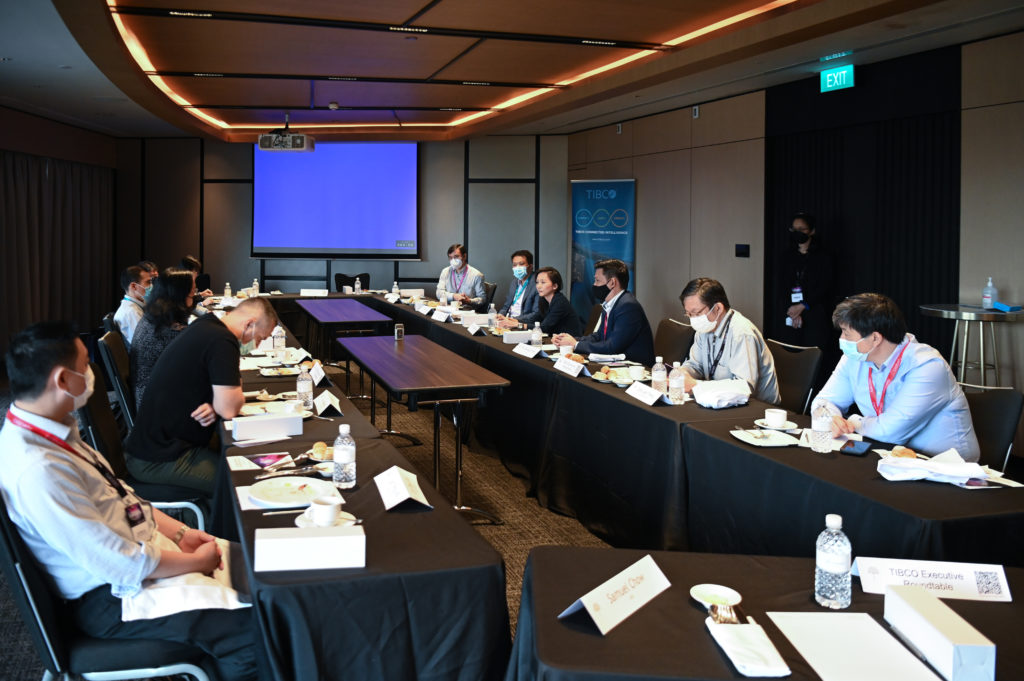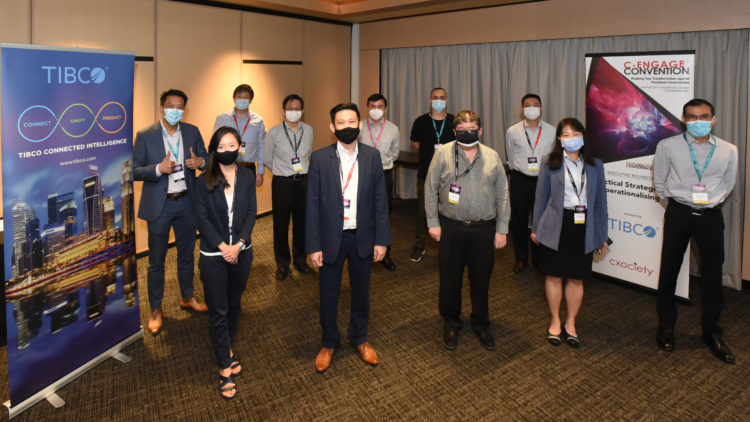One of Gartner’s 2021 predictions centres around the combination of data, analytics, and artificial intelligence, as organizations look to predict, prepare, and respond in a proactive and accelerated manner to a global crisis and its aftermath.
Gartner predicts that by the end of 2024, 75% of enterprises will shift from piloting to operationalizing AI, driving a 5X increase in streaming data and analytics infrastructures.
Together with FutureCIO, TIBCO recently hosted a multi-industry roundtable to share insights into taking AI adoption to the next step in the journey.

Source: CXOCIETY/FutureCIO
Getting data right

Regardless of industry, it is essential to any AI project that an organisation can access the data in a timely fashion, said San Zaw, vice president for consulting, APJ, TIBCO.
“That’s easier said than done obviously because a lot of that data comes from new and old systems. Even in healthcare, it is not very straightforward, as a lot of their systems are proprietary; to get access to the data and make it usable for the downstream data scientist is often a challenge,” he added.
Yeong Chien Tho, regional vice president for ASEAN and Greater China at TIBCO, added, “The challenge of legacy systems is compounded by the fact that the people who implemented them are no longer around to support.
“So, understanding the data on that spectrum is hard to figure out. There are also touchy areas, like data owners who say, ‘Don't touch my data, because I do not know where you're going to take this data and I am worried about that from a security perspective’. However, once we get through that, the next order of business is harmonising the data, because everybody keeps the data differently.
“International companies whose data sets are stored in different locations face additional hurdles. When you think about the data sovereignty conversation, cross-border data sharing, and more stop organisations from taking that next step to really operationalising AI. The end goal is clear, but to get there involves a lot of hurdles,” Tho said.
AI models are insufficient

Patrick Chia, director – CIG at the Integrated Health Information Systems (IHiS), said that AI shows a lot of promise in the areas of discovery, correlation, and learning. However, current AI models are insufficient to teach the systems.
“Today, we have an information overload in healthcare. Everybody will order every single test, and even after that, they wouldn't be able to figure out the diagnosis,” he said. “So, the challenge that we have is that 10%- 20% that really makes a difference … Now all AI models/learning models are probably not good enough to help the doctor.”
For one, Chia said AI is effective in pattern recognition – specifically in radiology, helping doctors detect whether a lump or lesion in an X-ray is growing or not growing.
“Yes, it can help in those areas, but the ability to contextualise and to figure out all the different inputs right through time … what is the meaning of it… it's very different,” Chia said. “I think pattern recognition does work and is able to discover correlations. But to have the ability to have true AI, it's a different story altogether. I think it will come, we have to do it, but I think we don't put enough effort into it.”
Getting the right technical expertise

Teng Joo Loh, vice president for digital IT transformation at ComfortDelGro, said technology providers have a role to play in making AI deployment easier for companies.
“What customers want is really a step by step – not only about deploying the solution. The solution is just a piece of the puzzle, there is the process, the talent you need to build – the knowledge and skillsets – all these are actually part and parcel of getting that right,” Loh said.
He added: “Vendors need to work with their partners to beef up and start to give a well-rounded approach to their solution. I think that's what I would always look for in a vendor to provide rather than selling me a solution because that doesn't help me in any way.”

Songhua Zhang, senior vice president for IT and machine learning engineering at Standard Chartered Bank, has seen “very mature offerings in terms of an end-to-end platform for organisations to develop their applications and they are highly customisable also”.
What needs further improvement is the open interfaces, he said.
“We prefer a platform that has an open interface because most organisations do not want to tie their technology to one vendor. They want to experiment – maybe try one product for one feature and another for others. So, they need open interfaces that would allow them to choose which certain feature from a vendor works for one of their business problems better and then another piece for another problem, and they can easily integrate them and then form their own platform.”
Zhang also added that as certain verticals such as the financial industry have some unique regulations, vendors should have easily customisable solutions – and “offer not just a technical solution but also incorporate your regulations your governance policy inside this whole end-to-end process that will make our life easier”.
Keeping things simple and aiming for quick wins

Julianna Chua, regional head of digital acceleration at EssilorLuxottica, encouraged vendors to keep things simple.
“Compartmentalise the problem and try not to inflate it. There is always a key problem to be solved, do that first and do that well. As it gets bigger with varying topics included, it might get too big to be solved," she said.
She pointed out that it is also about fast execution with a vision in mind.
“We know that in today's world things change in three months - when that happens, the project has to restart. It's important to thus deliver and show progress - therefore create a kind of stability or reliance to move to phase two.
“How do we put a different lens on business agility? How do we launch things in MVP (minimum valuable product)? Have the vision in mind, solve by delivering in MVPs and bring the agility to allow for changes whilst showing progress. This line of approach often reduces a failure to launch before it can kick-off,” said Chua.
The right way and the better way
Tho of Tibco agreed that from a business perspective, aiming for a quick win is a key to getting an AI project off the ground.

“Do not boil the ocean, just focus on one or two key use cases very clearly that will move the needle right for the business. And if we can demonstrate that in the quickest way that will gain a lot of traction. Once you see success, the business will be behind it, and they will start imagining what is possible,” said Tho.
Zaw of TIBCO stressed however that companies embarking on an AI project need to make a “conscious acceptance that it is going to an iterative process”.
“I am seeing quite a lot of best of breed technologies – an overly complex architecture mix of too many data platform and AI platform technologies - only to realise three months or six months down the road that business needs have changed.
“It becomes too complicated to incorporate those changes into that complex mix of data technologies. And worst of all it becomes too challenging and complex for the consumers of that platform to use it. That’s the biggest challenge that we're seeing,” he said.
For Zaw, data is by nature real-time, and companies must accept that.
“Today, of course, we go through the governance process and with various steps and it's not truly real-time. But data is organic, and it will find a way into the consumers’ hands. When we design our solutions, we must keep that in mind how to address these situations.
“I like one thing that was shared with me in this roundtable: the difference between AI and standard business APIs is that a business API doesn't change over time against the business logic it is designed for. If your understanding of business logic is correct – it’s solid, you can rest assured that it will keep working.
“But the AI model may change from something that has high effectiveness within a period of a week or two weeks when the data has changed, and we find that the effectiveness level goes down. So, we must design with iteration in mind. That's the most important point.
“The last point is the human factor. The AI journey must be inclusive in nature of whatever process you design. It cannot be specific groups responsible for different functions such as data lineage, metadata tagging etc. That approach is not sustainable and scalable.
“It must be an inclusive approach that allows data stakeholders such as business users to collaboratively enrich the data. These are some of the guiding lights or north stars that we can use in rolling out more effective AI projects,” concluded Zaw.





